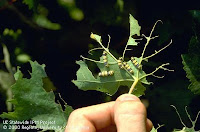Cabernet Sauvignon is the most widely recognized red wine grape. It is often called the "king" of red grapes. It may be surprising to find that the variety itself is actually a cross strain of two different grapes, Cabernet Franc as well as Sauvignon Blanc. Approximately 15 years ago some DNA testing was performed by a Doctor Carole Meredith of the U.C Davis department of Viticulture and Encology that found this discovery. In the 17th century in France (at least that is the belief) the two strains were accidentally cross bred together forming what we now know as Cabernet Sauvignon. The vines are very rot resistant and do fairly well in frost although as you can guess grape vines themselves are not meant for really cold weather.
Growing Cabernet Sauvignon in the desert (where I live) is very easy since the vines tolerate excessive heat and soil that you might think would not be so wonderful for plants. The vine loves rocky, sandy, gravel based soil. Gravel soil helps the vine by offering better draining and radiating the heat to the vines which aids in ripening. The emphasis in hot climates is actually on soil that is less fertile. this helps keep yields down since the vine can get out of hand if not watched closely. Too much yield can effect the grape by altering the quality and flavor of the wine. The wine can be less flavorful and edge towards a more "green" or Herbaceous flavor.
 |
| Skeletonizer (adult moth) |
 |
| Eutypella Scoparia |
 |
| Skeletonizer (destruction stage) |
 |
| Skeletonizer damage |
As well as being enjoyed simply as Cabernet Sauvignon the wine is also used quite often to blended with other wines. The wines that are usually used are Malbec, Petite Verdot or Carmendere although sometimes shiraz, Tempranillo and sangiovese are used in order to effect the taste.
Cabernet Sauvignon can be paired (drank with) with many foods. The general line of thought is that when the wine is young and has high Tannins it will go not go well with spicy foods. A food that is high in fats and proteins have a tendency to reduce the perception of Tannins in your mouth. The same thing goes for drinking the wine with foods that have a heavy butter cream sauce. Starches and pasta & rice have very little effect on Tannins. As Cabernet Sauvignon ages, the Tannins lessen more suttle and less bitter dishes will pair better with the wine
My take on this beautiful wine is like this. I happen to like an "oakey" wine that is fairly heavy on tannins. Wine is not for drinking in the way that beer is. Wine is really for sipping and since I like to actually taste how complex (or on the other hand how simple) a wine is. The above section that deals with paring a wine with food is what some might say "old school" or reserved for "wine snobs" who simply follow what they have been taught by other "wine snobs". I say drink that Cabernet Sauvignon with a nice steak that has been rubbed with spices and allowed to sit in the fridge for a few days. There are no "rules" that one cannot play around with. If the rules that we were all taught happen to hold hold up to a reality test then so be it. If however the rules we were all taught do not stand up to the reality test then we must make new rules. Hey guys it's wine and wine is meant for relaxing and drinking so lighten up and enjoy it the way you think it taste best.
The Desert Wine Guy



No comments:
Post a Comment